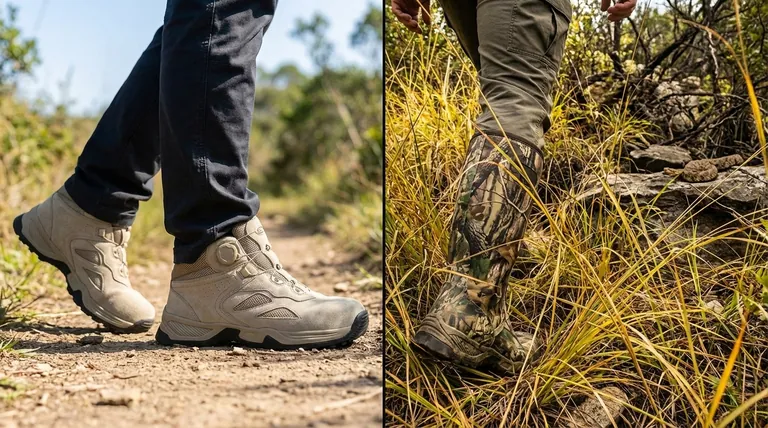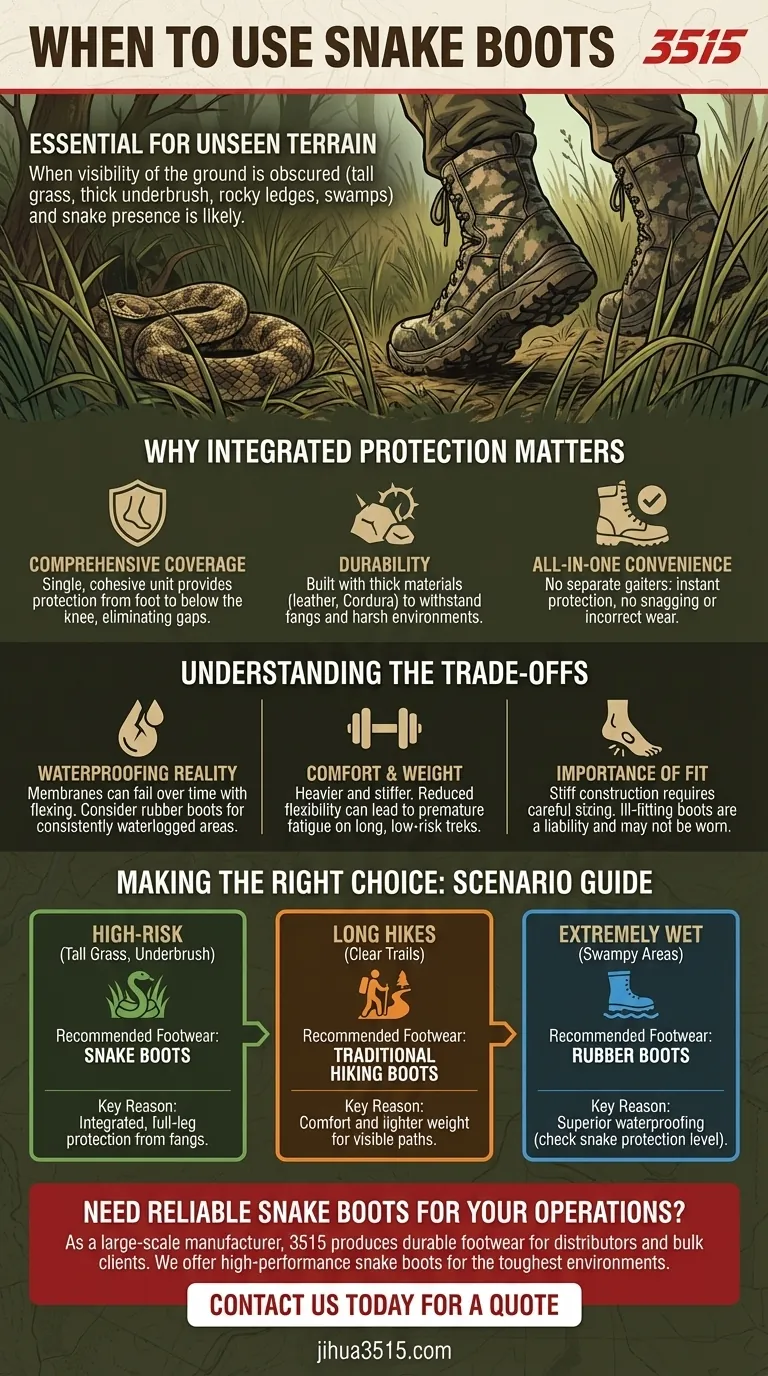In short, snake boots are essential when you are moving through terrain where you cannot clearly see where you are stepping. This includes areas with tall grass, thick underbrush, rocky ledges, or swamps—environments where snakes are likely to be present and concealed. They are specifically designed for high-risk situations where maximum protection is the priority.
The decision to wear snake boots hinges on a simple risk assessment: if the environment obscures your view of the ground and could harbor snakes, the superior, integrated protection of a dedicated boot is the most reliable choice.

Why Integrated Protection Matters
When navigating snake country, your primary goal is to prevent a venomous bite. While other options exist, dedicated snake boots offer a level of security that is difficult to replicate.
Comprehensive Coverage
Snake boots are constructed as a single, cohesive unit, typically providing protection from the foot to just below the knee. This integrated design eliminates gaps and weak points.
The materials used, such as thick leather, Cordura nylon, or other snake-resistant fabrics, are tested to withstand a snake's fangs.
Durability for Harsh Environments
These boots are built for more than just snake protection. They are designed for rugged use, with durable soles, strong stitching, and materials that resist abrasion from rocks and thorns.
This inherent toughness makes them suitable for off-trail hiking, hunting, and land management in challenging landscapes.
All-in-One Convenience
Unlike separate gaiters that must be put on over other footwear, snake boots are a single piece of equipment.
This simplicity ensures you are protected from the moment you put them on and eliminates the risk of gaiters snagging, shifting, or being put on incorrectly.
Understanding the Trade-offs
While offering unmatched protection, snake boots are a specialized piece of gear with specific drawbacks that you must consider. Their utility is defined as much by their limitations as by their strengths.
The Waterproofing Reality
Many snake boots are marketed as waterproof, which is a significant advantage in damp or swampy areas. However, this waterproofing is often a membrane that can fail over time.
With repeated flexing and exposure to harsh conditions, seams can separate and membranes can be punctured, leading to leaks. For consistently waterlogged terrain, a high-quality rubber boot might be a more reliable choice, though it may not offer the same level of puncture protection.
Comfort and Weight
Snake boots are, by necessity, heavier and stiffer than standard hiking boots. The protective materials add weight and reduce flexibility.
For long treks on well-maintained trails where snake risk is low, this extra weight and lack of comfort can lead to premature fatigue. It's crucial to balance the need for protection with the demands of your activity.
The Importance of Fit
An ill-fitting snake boot can be a significant liability. Due to their stiff construction, break-in periods can be longer, and hot spots or blisters are a common complaint.
Trying on different brands and reading user reviews is critical. A boot that causes discomfort is one you're less likely to wear, defeating its purpose entirely.
Making the Right Choice for Your Goal
Ultimately, the decision comes down to the specific risks and demands of your environment and activity.
- If your primary focus is safety in high-risk environments: Choose snake boots for their integrated, reliable protection when hunting, clearing brush, or hiking off-trail in known snake habitats.
- If your primary focus is comfort on long hikes: Opt for traditional hiking boots on clear, well-trodden paths where you can easily see the ground ahead.
- If your primary focus is navigating extremely wet or swampy areas: Consider high-quality rubber boots, but remain aware that they may not offer certified snakebite protection.
Choosing the right footwear is about making an informed decision that matches the real-world risks you will face.
Summary Table:
| Scenario | Recommended Footwear | Key Reason |
|---|---|---|
| High-Risk (Tall Grass, Underbrush) | Snake Boots | Integrated, full-leg protection from fangs |
| Long Hikes on Clear Trails | Traditional Hiking Boots | Comfort and lighter weight for visible paths |
| Extremely Wet/Swampy Areas | Rubber Boots | Superior waterproofing, but check snake protection level |
Need Reliable Snake Boots for Your Outdoor Operations?
As a large-scale manufacturer, 3515 produces a comprehensive range of durable and protective footwear for distributors, brand owners, and bulk clients. Our production capabilities encompass all types of safety boots, including high-performance snake boots designed for the toughest environments.
We can provide the durable, protective footwear your customers need. Contact us today to discuss your requirements and get a quote!
Visual Guide

Related Products
- Premium Wholesale Wheat Nubuck Safety Boot with Rapid Lacing System
- Customizable Anti-Smash Safety Boots for Wholesale & Private Label Manufacturing
- Premium Grain Leather Safety Boots for Bulk Supply
- Custom Wholesale Leather Safety Boots Direct Factory Manufacturing
- Premium Wholesale Waterproof Safety Boots High Performance Protection for Industrial Markets
People Also Ask
- What are penetration-resistant insoles in safety footwear? Steel vs. Textile for Ultimate Protection
- How do work boots provide impact and compression resistance? The Science Behind the Protective Toe Cap
- Why is it important to check the labels on steel cap work boots? Ensure Genuine, Certified Foot Protection
- How do safety features in work boots contribute to overall comfort and safety? Unlock the Secret to All-Day Protection
- What safety standards does the 11-inch waterproof pull-on boot meet? ASTM-Certified Protection for Industrial Work



















